Editor’s Note: This text course is an edited transcript of a live webinar. Download supplemental course materials.
Learning Objectives
- After this course learners will be able to identify 3 rationalizations for why those with hearing loss do not pursue hearing aids.
- After this course learners will be able to identify 3 new technologies available within the introduced family of hearing aids.
- After this course learners will be able to identify the microphone null pattern that allows for maximal hearing in the car.
Introduction
Dr. Luis Camacho: Today you will learn about our new product, the Z Series. Today I will be giving a general overview of what Z series can offer. We will touch on the statistics of hearing loss in the United States and around the world. I will discuss general education about the importance of hearing loss and doing something about hearing loss. Lastly, we will cover all the details on the Z Series product line.
Hearing is our Concern
The general theme of Hear Better, Live Better, Engage Better, Enjoy Better is what we think our profession of audiology promotes. Health tracking technology is becoming more popular, and people are paying attention to general health. That is something we should embrace as hearing health care professionals, incorporating this idea that better hearing is not just a standalone problem; it is part of a bigger picture. If a person is able to hear the best that they possibly can, it will enhance their overall life, their lifestyle, their ability to enjoy friends, family, and do things they love to do. We want to bring this idea of better hearing to the forefront.
At Starkey, hearing is our concern. As hearing professionals and as audiologists, we tend to think about hearing aids as a bit of plastic. Typically, our patients also think about that expensive little piece of plastic that they are going to put in their ears. What we provide our patients is much more than hardware; it is better hearing. It is an overall component of their everyday health and lifestyle. We will be talking about hardware and software today, but beyond that, we need to reach out to the public and educate them on how better hearing can enhance their lives.
Starkey
Starkey is a leader in global hearing health initiatives, as evidenced by our involvement in many community-wide programs that give the gift of hearing or enhance education about hearing health. The Starkey Hearing Foundation is our international charitable organization that fits people all over the world with hearing aids. Last year, we gave away over 100,000 hearing aids. The HearNow program is our domestic version of the Starkey Hearing Foundation in the United States. The Listen Carefully program ties in with our Scholastic program, which provides curriculum for elementary schools around the country to promote and educate children on better hearing and hearing protection. HearingAid.com is a consumer website that is designed to educate the public. Operation Change is our outreach with other charitable organizations around the world to go beyond hearing and focus on housing, clean water, et cetera. There is also Sound Gear and Tunz technology for hearing protection and safely listening to music on mobile devices. We live this mantra that Hearing is Our Concern.
Max Chartrand once said that the greatest mission we have in this industry is to educate the population - not only those with hearing loss, but their loved ones and colleagues - on the effects of hearing loss and its relationship with quality of life. This is something that we deal with every day. Patients come in and, unfortunately, may not always want what we are selling. In many cases, people are brought begrudgingly into our offices by spouses, children, and grandchildren. Even though it is an important step in providing better overall health and lifestyle, they may not want to be there.
Statistics
The hearing loss population in the United States has doubled since 1984. It will reach 41 million by 2025. That is a significant jump. Hearing loss is the third most common physical condition after hypertension and arthritis. This disorder is highly unrepresented to the general population. Other statistics are that 30% of people over 60 years old have a hearing loss. One in six Baby Boomers has a hearing loss; one in 14 Generation X people, which is up to the age of 40, has a hearing loss. We are also seeing a greater prevalence of early hearing loss due to the prevalence of earphones. Hearing loss is not going to go away. If anything, it is going to be worse because of the way people are so connected with mobile electronics.
People are thinking about their overall health again, and it is our job to incorporate hearing loss into that discussion. Figure 1 shows how hearing loss is connected to so many other health conditions. Smokers have a higher risk for hearing loss. If you have a hearing loss, you are five times more likely to be at risk for Alzheimer’s or dementia; you are three times as likely to have a fall incident.
We know noise exposure is connected with hearing loss. We know that depression is greater for people with hearing loss. Older adults are more likely to end up in the hospital if they have a hearing loss. The most significant statistic is that those with hearing loss are tied to a greater mortality. Hearing loss plays a major role in a number of potentially life-threatening disease, disorders, and events in life. We want to make sure that we are the people educating the general public, friends, family, and our patients on this.
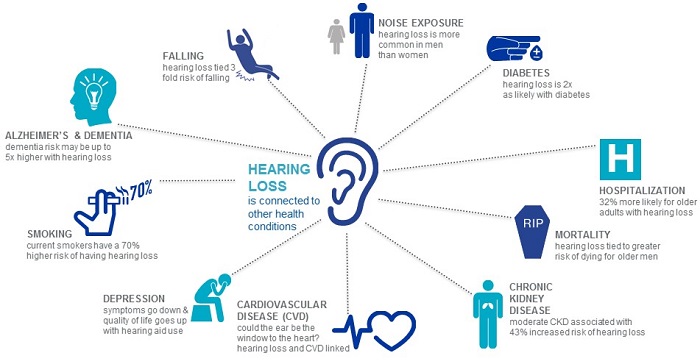
Figure 1. Hearing loss is connected to other health conditions.
There are many issues that you may encounter with your patients on a daily basis. They may be accompanied by their friends or family members while you review the case history and audiogram. Any one person in the party may tell you that they avoid social situations or that they may be embarrassed in different environments. Those are examples of the psychological side effects of hearing loss.
Unmotivated Population
Not only do we have a large group of adults in the United States that require our help, but they are unmotivated for the most part. Only 20% of people in the United States that could benefit from our services do anything about it. That leaves 80% who could benefit from our help and services to hear better and be more socially engaged. There are a number of reasons behind that.
Unfortunately, one idea is that they will wait another year and see what comes out next. This idea of the commoditization of hearing aids and hearing health care has made people think about hearing aids the same way they think about cellphones, televisions or computers. They think something better will come if they wait. That may be fine if you are waiting for a phone that has a bigger screen, but that is not the way we want to think about health care. If someone needs a heart valve, they do not wait until the next model comes out and save their money. They deal with it right then and there. That is the way we need people to see hearing health care.
We are well aware of the stigmas people may have about hearing aids and the costs associated with technology. However, we have a responsibility to help patients understand the truth behind hearing loss and quality of life. Even with the advent of Bluetooth ear pieces and almost universal acceptance of those devices, we still see marked resistance to hearing aids. The trend of wearable health trackers may make its way to ear-level technology. Perhaps we will see a hearing aid that also tracks your pulse and how many steps you take. As wearable technology becomes more and more common, hopefully the idea of having something on your ear will not be uncommon at all.
We need to do better at educating people that hearing aids really do work. We still face this issue with patients and even physicians; there is the idea that hearing aids do not work. Even people with mild hearing loss can benefit from amplification. We need to promote our profession. If we can get the general population to understand that hearing is a major part of overall health, then we are going to have an easier job promoting better hearing. Earlier hearing loss identification coupled with earlier treatment leads to greater success with amplification, which also includes a better hearing life. This is the message we need to perpetuate.
Z Series
With all of that in mind, we are excited to introduce a new, full product line called the Z series. In this portfolio, you have every device from standard power behind-the-ear (BTE), receiver in the canal (RIC) products, and all custom styles including a true wireless completely-in-the-canal (CIC). You have everything you need for any patient with Z series.
This is a new hardware platform with a new chip and wireless radio; every product is wireless. The operating system is BluWave 4.0; this is what makes it possible for the various adaptive algorithms to work in conjunction with each other. This is our most powerful chip and operating system to date. We are going to touch on the different components of what sets the Z series apart from other product lines.
Superior Sound
Starkey Superior Sound is made up of our e-Stat fitting formula, our new generation of compression called ISO-C (independent speech optimization clear compression), the latest version of PureWave feedback eliminator, and the introduction of a new automatic experience manager to make transitions into amplification easier for your patients.
e-STAT
Let’s start with e-Stat. A poster session at the Acoustical Society of America by the Starkey Hearing Research Center reported on a study to see how current fitting formulas translated to patients' preferred gain settings through a normal fitting process. Patients were fit using NAL-NL1 targets and were subject to follow-up appointments and adjustments. The authors found that after the normal fitting process, patients wanted their hearing aids set where our e-STAT fitting formula resides. What we are saying here is that the e-STAT is a great starting point. It provides the best first fit. For most patients, you will still have to make fine adjustments one way or the other, but it is a very good starting point in terms of patients' preferences.
This study validated what we have been doing with the evolution of e-Stat. With the latest version of Inspire, we have refined e-STAT even further. With a proprietary formula, we can adjust it as we gather more data. The targets are 2 dB lower than they used to be. Also, within the visual display on your computer, the resolution of the curves has been improved, meaning that our display is closer to what you would see in the real ear. We are getting better and better at displaying what is happening in the ear canal with this latest version of Inspire and e-Stat.
Figure 2 is a screenshot of e-STAT as the default fitting formula. You can select or change the fitting from the drop down menu in the upper right corner of the fitting screen.
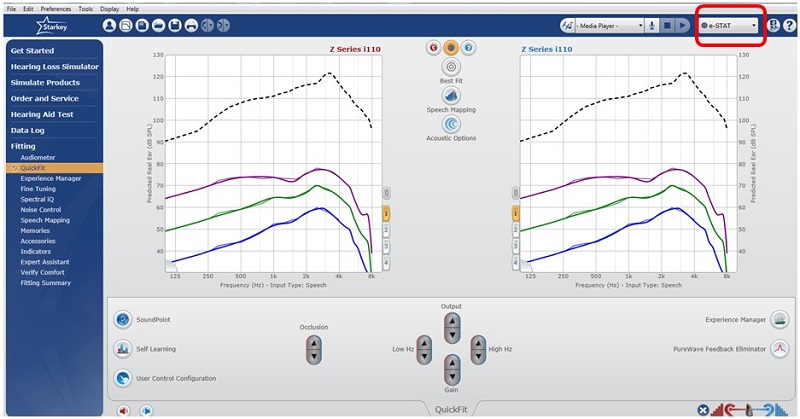
Figure 2. Inspire screen shot, indicting the default proprietary fitting formula, e-STAT.
ISO Compression
The newest generation of our ISO compression architecture is called ISO Clear (ISO-C). With ISO-C, we now have the widest dynamic range of any hearing aid in the industry. Our point of view in terms of “dynamic range” is the softest sound a person can hear and the loudest sound they can tolerate. With sensorineural hearing loss, we are talking about a narrowed dynamic range.
Dynamic range in a hearing aid is different. It is the softest and loudest inputs that the hearing aid can process without any distortion. There are a number of components that make up the dynamic range of a hearing aid, including the noise floor. Essentially, without any input, how much electronic internal noise does the hearing aid itself generate?
In the new ISO-C with BluWave 4.0 processing, we have improved modeling of what the microphone does. In previous models, we determined that the microphone location does have an impact on the internal noise floor. We have made more precise calculations on our multi-channel expansion, and we can better estimate what a tube and ear mold does for internal noise as well. We now have the noise floor on our BTEs and RICs as 6 dB quieter than ever before.
This expansion is backwards compatible with 3 Series and Xino wireless. We do have these new calculations for expansion, microphone effect, tubing and earmold effects. If you happen to have a patient with a 3 Series or Xino wireless RIC or BTE with complaints that the hearing aid is noisy, you can do a best fit and get these new microphone calculations to make the hearing aid quieter.
Another component to the dynamic range of the hearing aid is the front-end limiter. This is the highest input that can come into the hearing aid and not get changed before any of the processing occurs.
Output Compression Limiter
Next is our output compression limiter. With these things in place, we have improved our front-end limiter and now are able to provide greater headroom and give distortion-free sound quality. That means that hearing professionals will be able to adjust the hearing aid output for soft, moderate, and loud inputs. This way the hearing aid would fit it into a patient’s reduced dynamic range without introducing distortion. We do not talk about peak clipping anymore with digital technology, but the fact that you do have a limited output can introduce some sound quality concerns.
I am going to play a few sound files here. Clip 1 is the old version of ISO before extending the front-end limited and the headroom on the devices.
Overall, I think Starkey products have a good sound quality. However, listen to the new ISO-C with greater head room with the improved front-end limiter.
It has a cleaner sound quality that comes from this expanded dynamic range.
PureWave Feedback Eliminator
Our PureWave feedback eliminator continues to get better. PureWave now has a low sensitivity control for every product in the Z Series family. The low sensitivity is designed to counteract the potential of artifact with fast-acting phase-cancellation feedback systems. You might need this if you have a patient who notices that their own voice or other voices sound warbled. Some patients describe it as sounding like they are talking into a fan, which can occasionally occur with open ear molds and fast compression.
You can change the adaptive high-sensitivity setting to the adaptive low-sensitivity setting, and that should take away the sound quality artifact. There is a static mode, which is designed more for entrainment issues where the feedback canceller is generating a tonal sound in reaction to external sounds, such as music or the beeps on a microwave.
Auto Experience Manager
The Auto Experience Manager is new to the Z Series product family. While I will not go into this in detail, I wanted to show you where it resides in the software. You can turn on the Experience Manager and set the starting point and the amount of time you want the system to take to gradually increase the gain of the hearing aid, from two weeks to six months.
The Experience Manager resides on the lower portion of the fitting screen (Figure 3). You have the ability to start at a level one, two, or three, where three is the ending point or target. From the drop-down box, you can select how long you want the gradual gain increase to take.
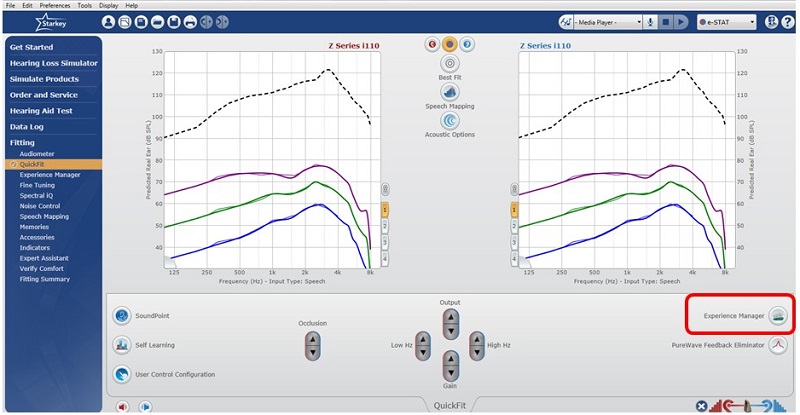
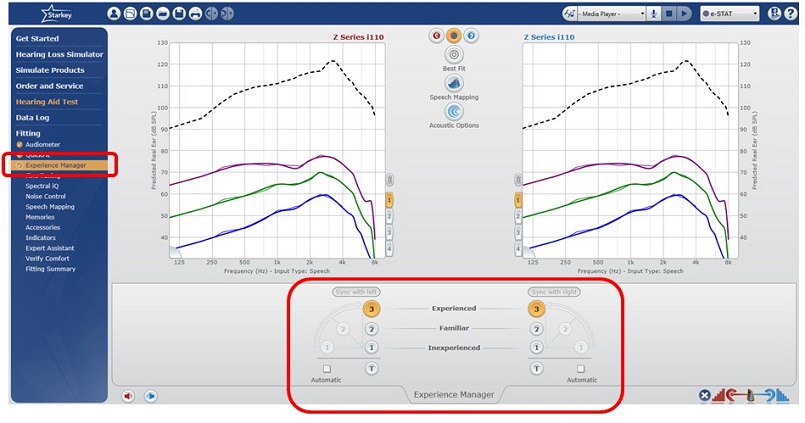
Figure 3. Screen shots from Inspire Experience Manager fitting selections.
The key in making this as effective as possible is to do your fine-tuning, perform real-ear verification, set the general sound quality where you want it, and then activate the Experience Manager. This will give you an advantage with those patients who are struggling to accept amplification at target gain.
Acoustic Scene Analyzer
The Acoustic Scene Analyzer incorporates our adaptive noise features. In particular, we have made our wind noise algorithm more aggressive with better attenuation. The difference between the 3 Series and the Z Series products is shown in Figure 4. We made these changes base on customer requests and feedback. The noise control settings in the software look very much the same. There are four levels, with level four being the most aggressive setting.
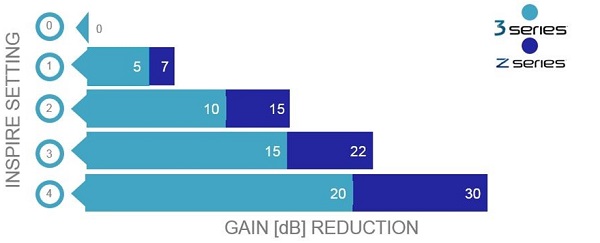
Figure 4. Wind noise algorithm enhancements from the 3 Series (light blue) to the Z Series (dark blue).
Acuity Directionality
We added Acuity Directionality to our noise program. I am not going to detail this feature today, but the take-away is that the Z Series products have multichannel adaptive null steering with our Speech ID algorithm. We have implemented new microphones known as MEMS microphones. These microphones allow us to do an adaptive null steering approach without the concerns of microphone drift and loss of directionality over time.
Acuity directionality has different polar plots in every channel of the instrument, and those polar plots will point the null at the most intense noise source in the environment. Using binaural spatial mapping, the trading of information back and forth between the hearing aids will allow for the best polar plot possible in the environment. MEMS microphones allow this without the drift of previous microphones. They will be more robust over time and give a consistent directional microphone performance for the life of the hearing aids.
Speech ID
Speech ID is a proprietary algorithm that is designed to recognize the presence of speech when it occurs behind the patient. A great example is the car. When you are in the car, the hearing aids will go into a directional plot because of noise to the side and rear of the patient. Then when you someone sits beside them, you have the ability to direct the microphones to the side at that communication partner. When someone speaks behind the patient, typical systems would still put a null point back there. Speech ID allows hearing aids to essentially point a lobe of sensitivity behind the patient so that they can pick up what is behind them in that environment. That is important in a number of situations.
This is the default within the software for any products that have directional microphones. There is now an adaptive feature selection in the software.
900 Sync
With the Z series, we have new hardware for wireless connectivity. Starkey introduced the 900 mHz system about five years ago, first with the Y Series and then up to the 3 Series products of last year. With Z Series, we have the second generation of hardware, antennae and the radio transmitter, and that is called 900 Sync.
We are simultaneously releasing the second generation of the SurfLink Mobile and SurfLink Mobile version 2. One thing I want to make clear is the 900 Sync is the hardware in the Z series, SurfLink Mobile 2 is the next generation of SurfLink Mobile, and it will work with any of our 900 mHz products.
The 900 Sync hardware in the Z series products does provide some benefits over the older antennae that were in the 3 Series, the Xino wireless and the Y Series. This new hardware in the Z Series products provides more interference-free connectivity. We are getting double the streaming distance, and that is true whether you are programming in your office, streaming with the SurfLink Mobile, or streaming with the SurfLink Media device at home using the remote control.
We also improved spatial streaming. The shadow of the head or body affects connectivity to some wireless accessories. Some patients would find scenarios where they were connected to a SurfLink Media and one of the hearing aids would drop out upon turning their head due to the baffling of their physical presence. This new 900 Sync antenna has improved that dramatically and we have greater streaming distance.
We have also added StreamBoost memory in the hearing aids. If you select StreamBoost in the programming, as soon as the hearing aids detect streaming of any kind, they will automatically switch into a stream-preferred sound quality for that patient. We have greater connectivity, less interference, less concern about body baffling or head-shadow effect, and an automatic switch into a streaming memory.
SurfLink Mobile 2
SurfLink Mobile 2 (Figure 5) is separate. This remote unit has an increased battery life over the previous version. We learned from the user interface in the Halo product with our TruLink app, and you are going to see more similarities with that in the SurfLink Mobile 2 interface. It is straight forward for the patient. There is much more personalization and the ability to take things away from the screen so that only the patient controls are available on the screen; it will not show things they are not using.
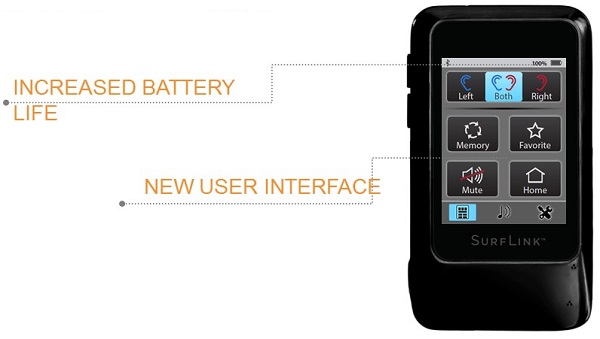
Figure 5. SurfLink Mobile 2 unit.
The software has changed slightly with the Z series products when it comes to wireless. Since the Z Series are all wireless products, we no longer have a tab on the left navigation bar that says “wireless.” It is now replaced with “accessories.” As before, click the accessory that the patient will have. It is more straight forward and more streamlined from a software point of view.
With Starkey, you do have our Made for iPhone platform as well as the 900 Sync platform that opens up wireless connectivity to patients of all different hearing aid configurations that use something besides an Apple product.
Multiflex Tinnitus
We have also introduced Multiflex Tinnitus Technology in a wireless RIC product. When we introduced Multiflex Tinnitus with the Xino Tinnitus product a couple of years ago, it took off as an excellent solution for those who are doing tinnitus management. Now it is available in the Z series 312 micro RIC style product. It is fully wireless with the 900 sync technology and has the same easy tinnitus stimulus programming that we had offered in the Xino Tinnitus product. This addition allows you to provide a tinnitus solution with more patients.
It still uses the Sound Point Tinnitus tool in the software to allow the patient to engage in programming of the tinnitus stimulus. There is a Multiflex Tinnitus tab on the left navigation bar, the ability to enable or disable the tinnitus stimulus on a per-memory basis, and the ability to tune it per channel and add modulation.
Product Line Summary
Figure 6 shows the technology levels from i20, through the flagship i110. All levels have the 900 sync wireless platform. They all have the new ISO-C for maximum head room and distortion-free sound quality. The micro RIC at all technology levels includes the Multiflex Tinnitus Technology. They all have the same directional microphones, feedback cancellation, and noise reduction. You have something to offer any patient regardless of style desire, power need, wireless technology, and price point.
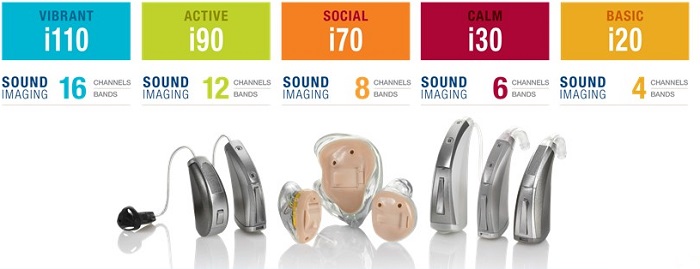
Figure 6. Z Series product line and technology levels.
When you couple this product family with the Made for iPhone Halo product family, you can fit the benefits of wireless technology to anyone who walks through the door with any style, any power need and audiometric configuration.
The Z series is truly an advancement in Starkey’s mission to Hear Better. Thank you for your attention today.
Questions and Answers
Speaking of backwards compatibility with the 3 series and Xino wireless, how do I keep the same settings in those products I have already fit?
The only thing that is backwards compatible to the 3 Series and Xino wireless is the reduced noise floor. Those are separate calculations from the headroom in the hearing aids. The only time I would say to do a new best fit with a 3 Series or Xino wireless would be if you have a patient who has complained about the hearing aid being noisy in quiet environments. With that person, I would do a best fit, which will render new calculations for the microphone location effect, the per-channel expansion calculations, and the earmold and tubing effects. This is only necessary on BTEs and RICs. You do not get the higher headroom or the greater front-end input limiter. It is just for the potential of noise in the RICs and BTEs in the previous products.
Is the tinnitus feature only in the micro RIC?
Yes. It is only in the micro RIC, but in all technology levels.
Cite this Content as:
Camacho, L. (2015, March). Hear better, live better: state of the art hearing technology. AudiologyOnline, Article 13643. Retrieved from https://www.audiologyonline.com.


